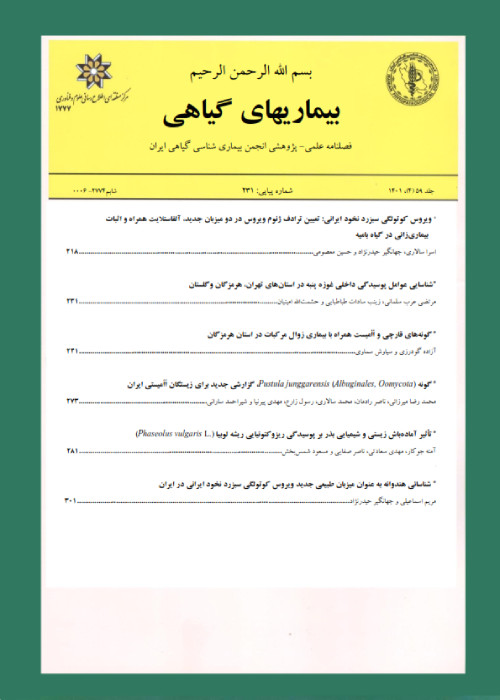FIRST REPORT OF Lecanicillium lecanii AND ITS SEXUAL STAGE, FROM IRAN
Abstract:
In the course of studies on population dynamics and spatial distribution of the tea cottony scale, Pulvinaria floccifera (Westwood) (Hemi.: Coccidae) in the tea gardens of Tonekabon (west of Mazandaran), in 2008-2009, infected cottony scales were found with hyphae and orange-flask shaped perithecia. They were grown separately on PCA and kept under isolated conditions and in incubator at 24-25ºC. After 10 days they were sent to Plant Protection Research Institute of Iran for further investigation. The collected pathogens were as follows: Lecanicillium muscarium (Petch Zare & Gams), Lecanicillium lecanii (Zimmerm. Zare & Gams). Lecanicillium lecanii: Colonies reach 15-25 mm in diam. in 10 days, being rather compact, yellowish white, with deep yellow reverse. Phialides which are relatively short, 11-20(-30)× 1.3-1.8 µm, aculeate and strongly tapering, are produced singly or in whorls of up to 6 directly on prostrate hyphae, or on short, more or less erect conidiophores. They are sometimes also produced secondarily on the previous phialides. Conidia are formed in heads at the apex of the phialides, typically short-ellipsoidal, 2.5 -3.5(-4.2) ×1-1.5µm, homogeneous in size and shape. Octahedral crystals are also present. Lecanicillium muscarium: Colonies reaching (14-) 25-30 mm in diam in 10 days, being rather compact, white, with cream-coloured to pale yellow (rarely yellow) or uncolored reverse. Phialides are produced directly on prostrate hyphae or on secondary branches. Secondary branches are less frequent than in L. lecanii. Phialides are generally longer than those of L. lecanii and less tapring, measuring (15-) 20-35× 1.0-1.7 µm. Conidia, are produced in globose heads, ellipsoidal to subcylindrisal, more irregular in size and shape, longer and narrower than in L. lecanii, measuring (2-)2.5-5.5(-6)×1-1.5(-1.8)µm. Octahedral crystals commonly present (IRAN 1650C). Torrubiella. cf. conferagosa: Mycelium is thin, white to cream color, covering scale insect and extending slightly beyond on the substratum, slightly tufed, pulverulent; perithecia are irregularly scattered to crowded over the scale, superficially or slightly embedded at the base in the mycelium. Asci are ovoid and cylindrical, and ascospores are filiform (IRAN 14441F).
Language:
Persian
Published:
Iranian Journal of Plant Pathology, Volume:46 Issue: 3, 2010
Page:
279
https://magiran.com/p805366
دانلود و مطالعه متن این مقاله با یکی از روشهای زیر امکان پذیر است:
اشتراک شخصی
با عضویت و پرداخت آنلاین حق اشتراک یکساله به مبلغ 1,390,000ريال میتوانید 70 عنوان مطلب دانلود کنید!
اشتراک سازمانی
به کتابخانه دانشگاه یا محل کار خود پیشنهاد کنید تا اشتراک سازمانی این پایگاه را برای دسترسی نامحدود همه کاربران به متن مطالب تهیه نمایند!
توجه!
- حق عضویت دریافتی صرف حمایت از نشریات عضو و نگهداری، تکمیل و توسعه مگیران میشود.
- پرداخت حق اشتراک و دانلود مقالات اجازه بازنشر آن در سایر رسانههای چاپی و دیجیتال را به کاربر نمیدهد.
In order to view content subscription is required
Personal subscription
Subscribe magiran.com for 70 € euros via PayPal and download 70 articles during a year.
Organization subscription
Please contact us to subscribe your university or library for unlimited access!



